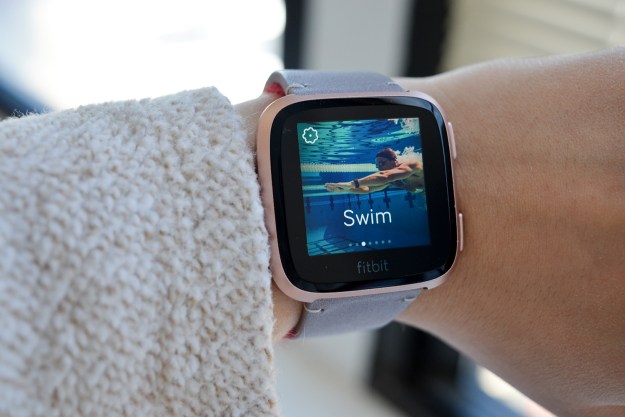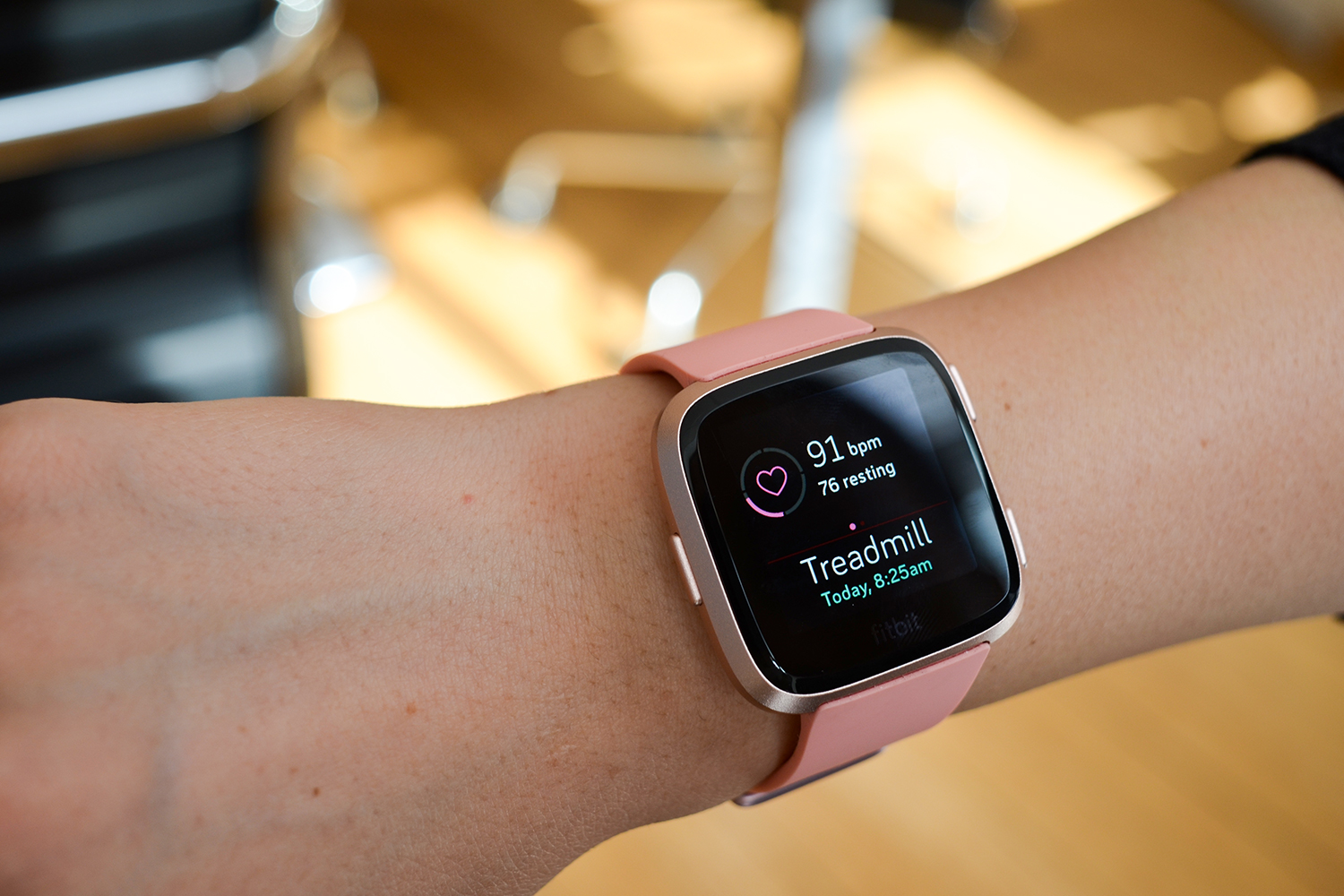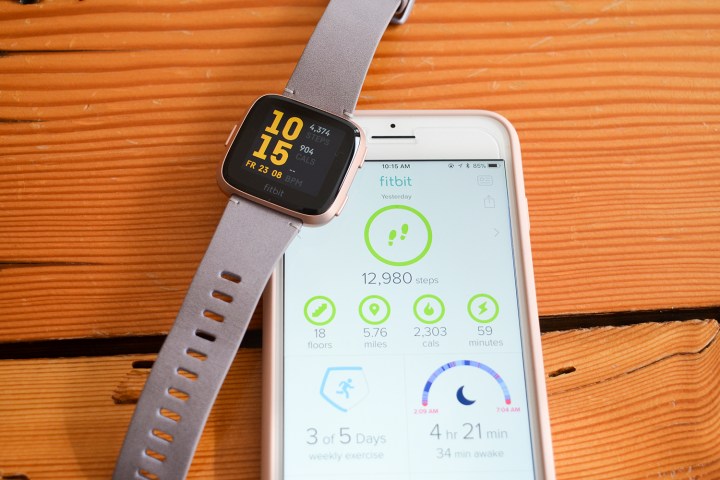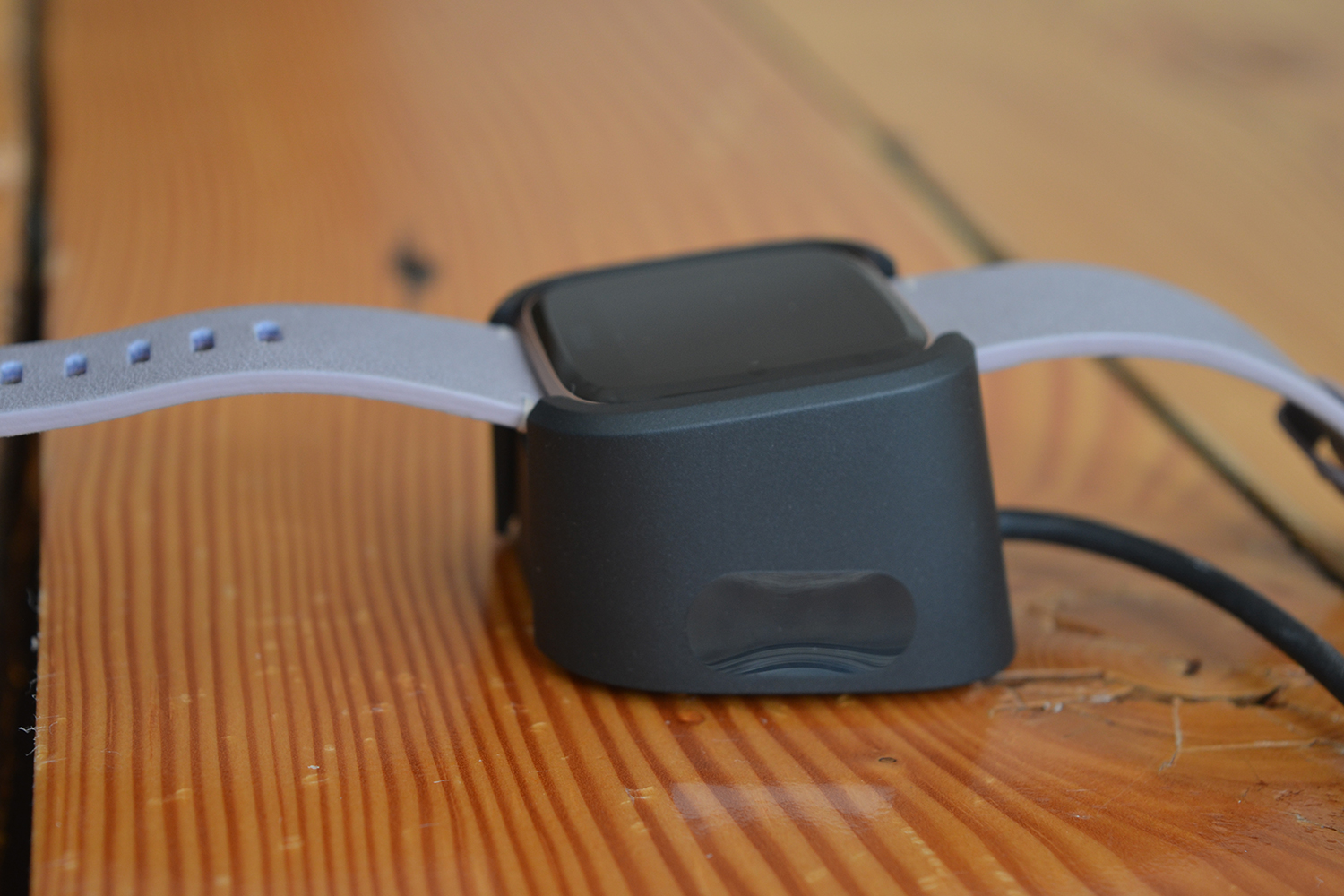
- Lightweight case
- Offers smartphone notifications
- Accurately monitors heart-rate
- Solid battery life
- Interchangeable bands
- Not fully compatible with iOS
- Small library of third-party apps
- Limited music services
Fitbit revels in calling its products the most popular fitness trackers around, but its latest wearables go beyond the simplistic nature of health and activity tracking. There’s now a clear emphasis on design — but more important, Fitbit is broadening the scope of its products by making them more like smartwatches.
The all-new Fitbit Versa doesn’t just look like the Apple Watch, it acts much more like a smartwatch than any of Fitbit’s previous products. At the same time, the Versa retains a focus on fitness and other health-related tracking. We put the Versa through rigorous testing to see if its updated software, fresh look, and overall performance outshines the best smartwatches on the market to put Fitbit back on top.
A familiar design
From a distance, it’s easy to mistake the Versa for the Apple Watch. Up close, we think the Versa looks a little better thanks to its chamfered edges. The Versa fits well on all wrists — male and female — and the 1.34-inch LCD screen is the perfect in-between size that doesn’t look too big on women or too small on men. It’s thin and compact, not taking up too much real estate on your wrist, which means you can pair it with other jewelry.
It also comes with two watch straps sizes (small and large) that you can interchange for the perfect fit. With women’s smartwatches especially, a bigger display often means a watch strap that’s too large. The Versa’s small watch strap fit perfectly on our wrist without having to buckle in at the highest notch.
With a 39.36 × 37.65 × 11.2-millimeter case size, the Versa looks slim from all angles. It also currently holds the title of being the lightest metal smartwatch (in the U.S.), which added to the comfort of wearing it — especially when working out. The buttons on the sides of the case are nice and flat, almost blending into the case and adding to its sleek finish.
We tested the rose-gold Versa with the peach silicone watch band and occasionally swapped it out with the lavender Horween leather band. The Versa is also versatile in aesthetics. Regardless of the occasion, we were able to customize it to match our outfits.
From a distance, it’s easy to mistake the Versa for the Apple Watch.
We preferred wearing the peach silicone band during the week because it meant we didn’t have to take it off before showering in the morning and after the gym. It’s more comfortable to wear while working out, as the leather band irritated our skin when sweat started to build up. We saved the Horween band for dressier outfits when we knew we weren’t going to work out.
There are also hundreds of different watch faces to choose from that don’t blatantly display all of your fitness stats for everyone to see. You’re even able to customize the color scheme of some of them to match your outfit or mood on a daily basis. You can also spend a little more money for the stainless steel and mesh bands if leather isn’t your style.
While the Versa does resemble the Apple Watch, we like Fitbit’s design choices, and most importantly, the watch is immensely comfortable to wear all day. The lightweight metal casing doesn’t make it feel high-end, unlike Apple’s wearable, though it’s understandable as the Versa is far more affordable.
Stats at a glance
With a tap on the screen or flick of the wrist — also known as “quick view”– you’ll awaken the Versa’s display. These actions aren’t always reliable, however, as the screen would often take a few taps to recognize our touch and actually turn on. A quick press of the home button on the right side alleviates the problem.
The clean interface neatly separates your data into tiles, making it easier to digest.
Swiping up gives you access to all of your fitness and health data via Fitbit’s redesigned dashboard. Rather than constantly using the Fitbit app on your phone, you can swipe up to see all of your stats immediately. The clean interface neatly separates your data into tiles, making it easier to digest.
At the top, there are some new tips and tricks as well as motivational messages you’ll receive every morning (you can easily turn these off). Below that is the step count and you can swipe to the left to reveal more data such as flights of stairs climbed, miles covered, calories burned, and active minutes. As you scroll down, you’ll find the steps taken in one hour along with your current heart rate, resting heart rate, and exercise summaries.
While the dashboard mainly provides daily stats, you can see how your stats compare on a weekly basis, too. In the background of both your step count and resting heart rate, you’ll see overview charts of the last seven days. For resting heart rate, simply swipe the tile to the left to see the entire week.
Being able to access in-depth summaries of stats on the watch without needing to constantly sync to the phone app is extremely convenient. We wish Fitbit extended this to its sleep tracking data, though, because you cannot see anything about how you slept without picking up your phone.
Starting in May, the dashboard is also where women can check on their menstrual cycle. By manually logging when your period occurs on the Fitbit app, the Versa will then showcase how many days until your next period, what day of your cycle you are currently on, and fertile windows. It’s a handy addition but we’ll have to wait to see how useful and accurate it is when it launches.
Solid performance and fitness tracking
Fitbit uses its own proprietary operating system (OS) on its devices and the Versa launches with Fitbit OS 2.0. It’s fairly responsive, though we’ve noticed some stuttering when scrolling through lots of notifications. A swipe to the left from the main clock watch face is where you’ll find your apps and by pressing and holding down on each app icon, you can drag them around to change the order.
We enjoyed using the Exercise app the most, which lets you choose from running, swimming, biking, weights, interval training, the treadmill, or a full body workout. If you want to load more on to your device, you can do so via the Fitbit app which offers over 19 workouts to choose from. By tapping on the specific workout, you’re able to track metrics like heart rate, time, distance, calories, and steps. Aside from syncing to the Fitbit app, this data also sits in the dashboard for you to reference at a glance.
We used the Exercise app to mainly to track running and the time we spent on the treadmill, but you can also use Fitbit Coach on the watch (or your phone) to follow certain guided workout routines. Fitbit OS 2.0 does also come with SmartTrack, which automatically recognizes your activity after 15 minutes. The downside is it’s only tracked on the Fitbit app on your phone and doesn’t show up on the watch’s dashboard.
In our running tests, we did notice the Versa tracked more distance than the treadmill, though this is largely due to the fact we didn’t alter our stride length on the watch. While you can input it manually — if you know it — there’s also the option to calculate it using your height and gender. As you continue to go on runs with GPS enabled, the Versa will further improve your stride length.
Running with our adjusted stride length provided slightly more similar results as the treadmill. Walking for 10 minutes, the Versa was only off in distance covered by 0.3 miles but running was off by around 0.1 miles — far less of a difference than before we adjusted our stride. These numbers aren’t major discrepancies with what the treadmill reported but it’s important to note.
The Versa also includes a built-in heart-rate sensor which produced similar beats per minute as when we manually tracked our heart rate. You can see your current and resting heart rate quickly on the dashboard. As mentioned earlier, the sensor also tracks sleep, though it’s only viewable via the summary of your night’s rest on the companion Fitbit app. It accurately showed us how much time was spent in light, deep, and REM sleep, along with how long we were awake.
The Versa is water resistant up to 50 meters but we didn’t have a chance to take it for a swim. We did take a few showers while wearing it and found no problems — we even ran it under water and the display was still as responsive as it was when dry.
Limited third-party apps
The Versa comes with 4GB of storage with 2.5GB of it available for music. You can either add your own songs manually or you can use the watch’s pre-loaded Pandora and Deezer
This is probably the worst part of the Fitbit Versa. It’s tedious (though manageable) to have to manually download MP3 files and sync it with the Fitbit app if you don’t want to pay for Pandora and Deezer. But what’s worse is having Pandora One and Deezer as the only two music services — Spotify, anyone? We clenched our teeth and installed Deezer and the experience of downloading and syncing music wasn’t too difficult. Still, we likely wouldn’t pay for it for our Versa considering we’re already on Spotify.
Playing the music we synced via Deezer on Bluetooth-connected earbuds — without our
Other pre-installed apps include Starbucks, Strava, and Weather, but you can download more through the Fitbit app. You likely won’t find any other useful apps — except perhaps Yelp or Nest — because Fitbit’s App Gallery is fairly limited. We do wish there were more apps to choose from, especially ones that could enhance the smartwatch’s capabilities.
Seamlessly receives all notifications
Specifically titled “Versa” for its versatility, we were interested to learn how well the watch handled as a smartwatch over a fitness tracker. Having worn both the Apple Watch and smartwatches that run Google’s Wear OS, we were used to getting immediate notifications from our phones on our wrists.
The Versa is capable of providing all the notifications you need. It vibrated every time we received a text message or alert from another app. When someone calls, you can also answer or decline straight from the smartwatch.
Since we connected the Versa to our iPhone 8 Plus, it’s important to note the experience is a bit different for iOS users. For starters, Apple keeps its ecosystem very tight-knit — you won’t be able to send or answer text messages from the Versa, just receive them. Android users, however, will be able to send quick replies, with up to five custom or pre-populated replies that are 60 characters or less, starting in May. Those with an
What’s even better is you can control which apps let notifications come through on the watch, or you can disable notifications entirely. If you’re disabling them outright, however, you may be better off buying a fitness tracker that doesn’t offer notifications.
Our biggest gripe about notifications is that they don’t disappear on the phone when you view them on the watch. We often had to clear text messages and notifications on our phone that we already read on the watch, which isn’t a good user experience.
As a minor note — any emojis you see on the watch show up wearing sweatbands on the Versa, which we found to be super cute.
Solid battery life
Unlike the Apple Watch and Google’s Wear OS smartwatches, you won’t need to charge the Versa every night. Sure, it doesn’t give you a comprehensive feature set like those devices but we were able to track multiple runs and receive notifications, and the watch still managed to last roughly three and a half days.
Packing a tiny 145mAh battery, Fitbit said the watch should last four days or more. We did use it a lot, testing every single feature, which is likely why it nearly went out of juice in the middle of our fourth day.
On day one of testing, we took it off its charger at 11 a.m.. After using it all day to track our activity, with only text message and call notifications turned on, it hit 88 percent by 9:15 p.m. After using apps like Fitbit Coach for a warm-up and the Exercise app to track our run on the treadmill, we were down to 64 percent by the end of the second night (while also still getting app notifications). By day three, we were a little worried the Versa wouldn’t make it through an evening workout but it did and we reached 32 percent by 11 p.m. — and that’s after using it to run about three miles with connected GPS while playing music via the built-in Deezer app.
By the morning of day four, we got a notification letting us know the Versa’s battery was low.
Again, we were using the Versa far more than you usually would, so we can easily see it lasting four or more days, especially if you only work out about once a day. Fitbit said the Versa takes two hours to fully charge, but it only took an hour and a half for us using the Fitbit charging dock and our own wall adapter.
Price and warranty information
The Fitbit Versa costs $200 for the black with a black aluminum case, gray with a silver aluminum case, and peach with a rose gold case. The smartwatch is available for purchase worldwide via Fitbit’s own website, along with retailers in North America such as Best Buy, Amazon, Kohl’s, Target, Verizon, and Macy’s, among others. The Fitbit Versa Special Editions — which includes support for Fitbit Pay — are priced at $230 and are currently available for pre-order.
Fitbit offers a 45-day money back guarantee and a one-year limited warranty, which covers manufacturer defects.
Our Take
The Fitbit Versa is a comfortable and stylish smartwatch, with a battery life that lasts far longer than competing smartwatches. Its heart rate and in-depth fitness tracking capabilities — paired with notifications via Fitbit 2.0 — make it a steal for $200.
Is there a better alternative?
It depends on what you want. If you’re looking for the best fitness tracker — something that doesn’t flood your display with
If you prefer a smartwatch with less intense fitness tracking capabilities, the Misfit Vapor uses its own Misfit app to track sleep and daily activity. Also at $200, it includes a built-in heart rate sensor and an even bigger AMOLED display than the Versa. It runs Google’s Wear OS, so you can use Google Fit or other
For Apple users looking for an iOS compatible device, the Apple Watch Series 3 is your best bet. You’ll be able to choose from a large library of apps and answer text messages or other notifications. While it is more expensive at $330, it’s the only smartwatch that provides you with the most features when paired with the iPhone.
How long will it last?
The Versa feels durable and it’s water-resistant, so we think it should last two years or more. We do hope Fitbit continues to release updates and include more compatible apps to keep up with the competition.
Should you buy it?
Yes. Regardless if you’re a fitness buff or not, the Versa gives you plenty of customization options and easily adjusts to your lifestyle.
Updated April 16: The Fitbit Versa is now available for purchase worldwide


















